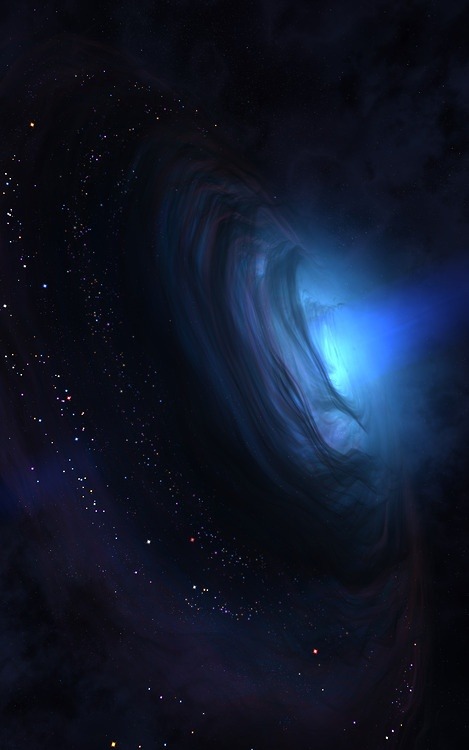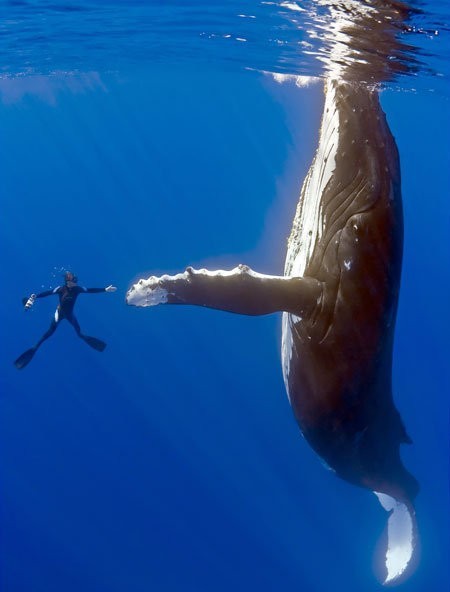Space Is So Creepy And Wonderful. Who The Hell Needs Hell When There’s Space.
Space is so creepy and wonderful. Who the hell needs hell when there’s space.
Like there’s an old constellation called Eridanus that you can see in the southern sky, and its not a very interesting constellation. It’s a river. It’s actually the water that’s pouring out of Aquarius, so in the sky it’s kind of boring. It’s a path of stars.
But within Eridanus, in between the stars, there’s a place where the background radiation is unexplainably cold. Because after the Big Bang, there was all this light that scattered everywhere, and it’s the oldest light in the universe, but we can’t see it. It’s so dim that it only shows up as a glow of microwaves, so to us, it just looks like the blackness of the night.
But there’s this spot in Eridanus where that little glow of ancient microwaves isn’t what it should be. It’s cold and dark.
And it’s enormous. Like a billion light year across. Of mostly just emptiness. And we don’t know why. One theory is that it’s simply a huge void, like a place where there are no galaxies. Voids like that do exist. Most of them are smaller, but they’re a sort of predictable part of the structure of the universe. The cold spot in Eridanus, if it were a void, would be so enormous that it would change how we understand the universe.
But another theory is that this cold spot is actually the place where a parallel universe is tangled with our own.
More Posts from Outofambit and Others
Tree honorifics
You whose roots go down forever; the whisperer of all twelve winds; strong against the storm; harbour of birds; knot of your own tying; you whose glades dance in dappled delirium; seeder of a thousand saplings; who stands alone at the hilltop; anchor of the oldest forest; you of the dancing green; you who rise again after endless Winter; the thorn in the thicket whom no axe will move; you who have grown silently; observer of nine centuries; to whom all paths lead; whose branches snag both clouds and dreams; the lord of your own grove; berry-provider; moss-grower; whose heartwoods are ancient secrets.
<3
Young Wizards meta: In "So You Want to Be a Wizard", where is the Lone Power's HQ?
At the Top of the Rock observation deck, and I’m debating with my sister over which building was probably the one that held the Dark Book in the overshadowed Manhattan…
It gave Kit an annoyed look. “All right, so I’m ambivalent,” the Lone One said. “But isn’t ambivalence preferable to pure evil?” Kit considered that one for a moment. “See? You’re buying it already,” the Lone One said. “I was getting bored with absolute evil, anyway. I find that you can do lots more damage with ambivalence. … "People are eager to excuse it, though. Ambivalence is seen as a sign of maturity, wheras actually taking a stance on one side or another is easy to describe as simplistic. Or unsophisticated. Or juvenile."
-Wizard’s Holiday by Diane Duane
[yells to the heavens] THIS IS WHY I LOVE YA LIIIIIT
(via trailofdesire)



The Journey to Mars Begins Tomorrow
NASA is preparing for the first test flight of the Orion crew vehicle set for an unmanned launch on Dec. 4 at 7:05 a.m. EST from Cape Canaveral, Florida.
The Orion spacecraft is designed to eventually take astronauts beyond low-Earth orbit to destinations never explored by humans. It will serve as the exploration vehicle that will carry the crew to distant planetary bodies, provide emergency abort capability, sustain the crew during space travel, and provide safe reentry from deep space.
This mission is the first of three trial runs that the Orion mission must overcome before NASA deems it safe enough for human space travel.
The next test flights in 2018 and 2021 will use NASA’s Space Launch System rocket (SLS), which is currently in development. When it’s finished, SLS will be the most powerful rocket ever built, boasting even more thrust than the Saturn V booster that blasted astronauts toward the moon in the Apollo era.
The spacecraft will launch atop a Delta IV Heavy, a rocket built and operated by United Launch Alliance. While this launch vehicle will allow Orion to reach an altitude high enough to meet the objectives for this test, a much larger, human-rated rocket will be needed for the vast distances of future exploration missions.
Exploration Flight Test-1, will mark the farthest distance traveled by a human spaceflight vehicle since 1972 made by Apollo 17.
During its grueling four-and-half-hour test mission, NASA’s Orion space capsule must shoot 3,600 miles away from Earth (15 times higher than the International Space Station!), orbit the planet twice, and brave a thick belt of cosmic radiation.
Upon re-entry it must deploy 11 parachutes to slow down from 20,000 miles per hour to 20 mph, while withstanding 4,000-degree Fahrenheit temperatures before plunging into the Pacific Ocean.
Check out these incredible photos from the development and testing of the spacecraft.
Countdown, launch and mission coverage will begin at 4:30 a.m. on NASA TV which is available on air and streaming at nasa.gov/nasatv

The Tinker Bell Triplet.
Using ESO’s Very Large Telescope, an international team of astronomers has discovered a stunning rare case of a triple merger of galaxies. This system, which astronomers have dubbed ‘The Bird’ - although it also bears resemblance with a cosmic Tinker Bell - is composed of two massive spiral galaxies and a third irregular galaxy.
Image Credit- ESO.


Kepler Mission Analysis Shows Reduced Number of Earth-Sized Planets in Field of View
A large number of worlds found by NASA’s Kepler alien planet-hunting space telescope are probably significantly larger than scientists previously estimated, a new study suggests. Using a galaxy similar to our own Milky Way, the image above shows the scale of the distances for the sample of stars with planet candidates described in a new study by scientists using the Kitt Peak National Observatory Mayall 4-meter telescope . The circled dot represents the position of the sun in the Milky Way, and the stippled cone shows how far away the new candidate stars are (2800-7000 light years), compared to the size of our galaxy.
The Kepler Space Telescope has spotted more than 2,700 potential exoplanets since its launch in 2009, and scientists using the Kitt Peak National Observatory categorized the home stars of many of those planet candidates for the past three years. In particular, the researchers made detailed follow-up observations of 300 of the stars Kepler found likely to be harboring exoplanets.
The Kepler satellite, in orbit around the sun, stares at a region of the northern hemisphere sky sandwiched between the bright stars Vega and Deneb. Attached to the telescope is the largest imaging camera ever flown into space—16 million pixels—the only instrument on the telescope and the one used to monitor all the stars in its search for planets. Planets are detected if they pass in front of their parent sun, causing a very slight dip in the star’s brightness. When this dip repeats periodically, it reveals the presence of a possible planet, the length of the planet’s “year”, and other information.
One of the main findings of this initial work is that our observations indicate that most of the stars we observed are slightly larger than previously thought and one quarter of them are at least 35 percent larger,” astronomer and leader of the study Mark Everett said in a statement. “Therefore, any planets orbiting these stars must be larger and hotter as well. By implication, these new results reduce the number of candidate Earth-size planet analogues detected by Kepler.”
Read

Incredible photograph of the Sun, with the spicules that cover most of the Sun clearly visible as the carpet like texture of the surface. Near the top, several active sunspots can also be seen as the black marks on the surface. Sunspots usually appear in pairs: being created due to magnetic activity, each sunspot of a pair having the opposite magnetic pole of the other.
-
 nvmndmx liked this · 2 months ago
nvmndmx liked this · 2 months ago -
 darthlenaplant liked this · 4 months ago
darthlenaplant liked this · 4 months ago -
 fifty2pickup reblogged this · 1 year ago
fifty2pickup reblogged this · 1 year ago -
 thisisgettingdifficult reblogged this · 1 year ago
thisisgettingdifficult reblogged this · 1 year ago -
 glitterdreamcatchers reblogged this · 1 year ago
glitterdreamcatchers reblogged this · 1 year ago -
 glitterdreamcatchers liked this · 1 year ago
glitterdreamcatchers liked this · 1 year ago -
 dream-in-a-jar liked this · 1 year ago
dream-in-a-jar liked this · 1 year ago -
 saphicspacesociety19 reblogged this · 1 year ago
saphicspacesociety19 reblogged this · 1 year ago -
 kathstudyinspo liked this · 1 year ago
kathstudyinspo liked this · 1 year ago -
 saphmiu liked this · 1 year ago
saphmiu liked this · 1 year ago -
 arthina reblogged this · 1 year ago
arthina reblogged this · 1 year ago -
 spyglassrealms liked this · 1 year ago
spyglassrealms liked this · 1 year ago -
 netreysterodiz liked this · 1 year ago
netreysterodiz liked this · 1 year ago -
 siriuslypoppunk reblogged this · 1 year ago
siriuslypoppunk reblogged this · 1 year ago -
 fysanayairani liked this · 1 year ago
fysanayairani liked this · 1 year ago -
 bluestice liked this · 1 year ago
bluestice liked this · 1 year ago -
 exapno liked this · 2 years ago
exapno liked this · 2 years ago -
 dragonwolf3416 reblogged this · 2 years ago
dragonwolf3416 reblogged this · 2 years ago -
 dragonwolf3416 liked this · 2 years ago
dragonwolf3416 liked this · 2 years ago -
 quadriviummuse reblogged this · 2 years ago
quadriviummuse reblogged this · 2 years ago -
 quadriviummuse liked this · 2 years ago
quadriviummuse liked this · 2 years ago -
 ridazzle reblogged this · 2 years ago
ridazzle reblogged this · 2 years ago -
 ridazzle liked this · 2 years ago
ridazzle liked this · 2 years ago -
 venus-light liked this · 2 years ago
venus-light liked this · 2 years ago -
 birdsbonecabin liked this · 2 years ago
birdsbonecabin liked this · 2 years ago -
 cenli liked this · 2 years ago
cenli liked this · 2 years ago -
 did-u-know-collection reblogged this · 2 years ago
did-u-know-collection reblogged this · 2 years ago -
 browniepokemon-reblogs reblogged this · 2 years ago
browniepokemon-reblogs reblogged this · 2 years ago -
 narfingpotato reblogged this · 2 years ago
narfingpotato reblogged this · 2 years ago -
 browniepokemon liked this · 2 years ago
browniepokemon liked this · 2 years ago -
 flowermancy reblogged this · 2 years ago
flowermancy reblogged this · 2 years ago -
 lu-cid-sky liked this · 2 years ago
lu-cid-sky liked this · 2 years ago -
 fanfictionbard reblogged this · 2 years ago
fanfictionbard reblogged this · 2 years ago -
 fanfictionbard liked this · 2 years ago
fanfictionbard liked this · 2 years ago
A personal temporospatial claudication for Young Wizards fandom-related posts and general space nonsense.
288 posts


